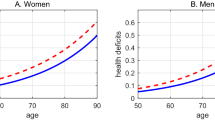Abstract
Increases in median ages, the most commonly used measure of population ageing1,2, are rapid in today's wealthier countries2,3, and population ageing is widely considered to be a significant challenge to the well-being of citizens there4. Conventional measures of age count years since birth; however, as lives lengthen, we need to think of age also in terms of years left until death or in proportion to the expanding lifespan. Here we propose a new measure of ageing: the median age of the population standardized for expected remaining years of life. We show, using historical data and forecasts for Germany, Japan and the United States, that although these populations will be growing older, as measured by their median ages, they will probably experience periods in which they grow younger, as measured by their standardized median ages. Furthermore, we provide forecasts for these countries of the old-age dependency ratio rescaled for increases in life expectancy at birth5. These ratios are forecasted to change much less than their unscaled counterparts, and also exhibit periods when the population is effectively growing younger.
This is a preview of subscription content, access via your institution
Access options
Subscribe to this journal
Receive 51 print issues and online access
$199.00 per year
only $3.90 per issue
Buy this article
- Purchase on Springer Link
- Instant access to full article PDF
Prices may be subject to local taxes which are calculated during checkout


Similar content being viewed by others
References
Gavrilov, L. A. & Heuveline, P. in The Encyclopedia of Population Vol. 1 (eds Demeny, P. & McNicoll, G.) 32–37 (Macmillan Reference USA, New York, 2003)
United Nations. World Population Prospects-The 2004 Revision: Highlightswww.un.org/esa/population/publications/WPP2004/2004Highlights_finalrevised.pdf (2005).
Lutz, W., Sanderson, W., Scherbov, S. & O'Neill, B. in The End of World Population Growth in the 21st Century: New Challenges for Human Capital Formation and Sustainable Development (eds Lutz, W., Sanderson, W. & Scherbov, S.) 85–120 (Earthscan, London, 2004)
Peterson, P. Gray Dawn (Random House, New York, 1999)
Lee, R. D. & Goldstein, J. R. in Life Span: Evolutionary, Ecological, and Demographic Perspectives. A Supplement to Population and Development Review Vol. 29 (eds Carey, J. R. & Tuljapurkar, S.) 183–207 (Population Council, New York, 2003)
Miller, T. Increasing longevity and Medicare expenditures. Demography 38, 215–226 (2001)
Seshamani, M. & Gray, A. M. A longitudinal study of the effects of age and time to death on hospital costs. J. Health Econ. 23, 217–235 (2004)
Stearns, S. C. & Norton, E. C. Time to include time to death? The future of health care expenditure predictions. Health Econ. 13, 315–327 (2004)
Hurd, M., Smith, J. P. & Zissimopoulos, J. The effects of subjective survival on retirement and social security claiming. J. Appl. Econometr. 19, 761–775 (2004)
Gan, L. Gong, G. Hurd, M. & McFadden, D. Subjective Mortality Risks and Bequests (NBER Working Paper 10789, National Bureau of Economic Research, Cambridge, Massachusetts, 2004).
Lee, R. & Tuljapurkar, S. Death and taxes: Longer life, consumption, and social security. Demography 34, 67–81 (1997)
Creighton, S. & Hudson, A. L. Participation Patterns in Adult Education, 1991–1999 (US Department of Education, Washington DC, 2002)
Bloom, D. E., Canning, D. & Graham, B. Longevity and life-cycle savings. Scand. J. Econ. 105, 319–338 (2003)
Higgins, M. Demography, national savings, and international capital flows. Int. Econ. Rev. 39, 343–369 (1998)
Disney, R. Crisis in public pension programmes in OECD: What are the reform options? Econ. J. 110, F1–F23 (2000)
Lutz, W., Sanderson, W. & Scherbov, S. The end of world population growth. Nature 412, 543–545 (2001)
Lutz, W., Sanderson, W. & Scherbov, S. in The End of World Population Growth in the 21st Century: New Challenges for Human Capital Formation and Sustainable Development (eds Lutz, W., Sanderson, W. & Scherbov, S.) 17–84 (Earthscan, London, 2004)
Sanderson, W. & Scherbov, S. Putting Oeppen and Vaupel to Work: On the Road to New Stochastic Mortality Forecasts (Interim Report IR-04–049, International Institute for Applied Systems Analysis, Laxenburg, Austria, 2004)
Oeppen, J. & Vaupel, J. Broken limits to life expectancy. Science 296, 1029–1031 (2002)
Author information
Authors and Affiliations
Corresponding author
Ethics declarations
Competing interests
Reprints and permissions information is available at npg.nature.com/reprintsandpermissions. The authors declare no competing financial interests.
Supplementary information
Supplementary Table S1
Data on unstandardized median age, life expectancy at the median age (median expected remaining years of life), standardized median age and standardized median age for subjects in study. (DOC 131 kb)
Supplementary Table S2
Conventional and Rescaled Old Age Dependency Ratios for Japan and Germany, 2000-2100. (DOC 53 kb)
Rights and permissions
About this article
Cite this article
Sanderson, W., Scherbov, S. Average remaining lifetimes can increase as human populations age. Nature 435, 811–813 (2005). https://doi.org/10.1038/nature03593
Received:
Accepted:
Issue Date:
DOI: https://doi.org/10.1038/nature03593
This article is cited by
-
Congressional symmetry: years remaining mirror years served in the U.S. House and Senate
Genus (2023)
-
Examining the risk of substance use and lifestyle factors on cognitive decline among older people in India
Journal of Public Health (2023)
-
The measurement of structural ageing – an axiomatic approach
Journal of Population Research (2023)
-
Modifications of Traditional Formulas to Estimate and Project Dependency Ratios and Their Implications in a Developing Country, Bangladesh
Population Research and Policy Review (2022)
Comments
By submitting a comment you agree to abide by our Terms and Community Guidelines. If you find something abusive or that does not comply with our terms or guidelines please flag it as inappropriate.



